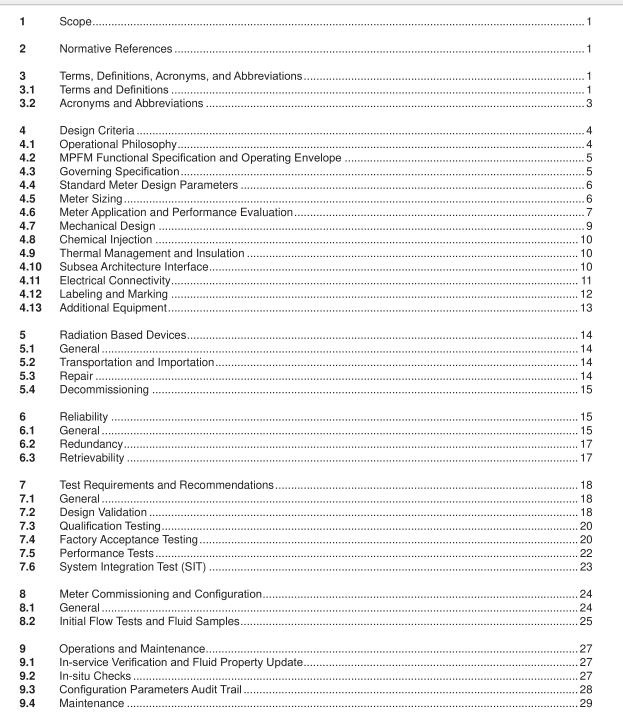API RP 17S pdf download

API RP 17S pdf download Recommended Practice for the Design, Testing, and Operation of Subsea Multiphase Flow Meters
uesign vrneria
4.1Operational Philosophy
The operator shall provide an operational philosophy that includes the following.
a) Intended use of the MPFM data and the frequency of data transmission and accumulation.b) The number of wells to be measured with each MPFM.
c)Location of the MPFM within the subsea architecture.
– The location of the MPFM is dependent on its intended application and the overall field layout. For
continuous measurement from individual wells, the MPFM may be located within a tree as part of a chokebridge/flow module/retrievable module, or as part of a jumper. Subsea MPFMs can typically be configuredto measure multiple wells intermittently. In this case,the MPFM can be placed in a manifold with thecapability to route the flow from individual wells to the MPFM.
d)Access requirements for retrieving and installing MPFMs and MPFM electronic modules.
e) Valve requirements (including operational reliability) for routing different wells through a single MPFM.f)Reliability requirements for the MPFM.
g) Requirement to verify and calibrate the MPFM accounting for the uncertainty of any available in-situ
verification methods—e.g. test separator or computational well model and availability of samples.
h) Methods of accounting correctly for gas lift or washwater injection upstream of the MPFM, and the effect on
the salinity of produced water.
i) Production rates that the MPFM is to be designed for.
j)Anticipated operational and flow-assurance concerns as well as PVT characterization.k)Details of any chemical injection regime(see 4.8).
The manufacturer and operator together shall specify the following.
i) Methods of verification of MPFM capability to measure fluid flows within the specified uncertainty range,
throughout field life (see Performance Testing,Section 7.5).
il) Methods of determining impact of change in fluid composition on performance.
NOTE Particular care is required for applications where hydrocarbon composition is expected to change over time, orwhere salinity of water is expected to change over time.
ill) Methods of continuously monitoring MPFM performance and identifying anomalous readings.
iv) Where production profile spans more than one MPFM performance range or size and consider designing
for more than one MPFM to meet the performance and production objective noting that some MPFMs aredesigned for liquid-dominant or gas-dominant multiphase flow (i.e. not for the full range of GVF).
v) Performance requirements for the MPFM including uncertainty,repeatability,and reproducibility. ISor
IEC Guide 98-3:2008 (GUM:1995) and lSO/TR 5168;2005 can be used to help understand uncertainty,repeatability, and reproducibility.
4.2MPFM Functional Specification and Operating Envelope
Afunctional specification shall be provided by the manufacturer, which shall include the following.1)Describe the measurements provided by the MPFM.
2)Provide an overview of the methodology used by the MPFM, including specific technologies used.3)Describe any required inlet and outlet piping configuration.
4) Outline how constituent flow rates are determined from the meter in-situ physical measurements,flow
models, and configuration input parameters.
5) Describe all required inputs,including specific fluid property data needed for the meter to perform to
specification.
6)llustrate the elements of the flow computation process.
7) Form the basis of meter sizing,performance testing,verification, and uncertainty determination for the
MPFM.
8) Document the process for calibration of the MPFM, including proposed methods for obtaining calibration
parameters required.
9)Describe the intended relationship betweensensorfunctionality and flow model versus expected performance.This demonstrates that the measurement technology is capable of achieving a specific uncertainty for a
particular flow regime based on reliable process information.
NOTE1 MPFMs use various measurement technologies to ascertain different parameters regarding the flow stream,there is no one standard technology.API MPMS Chapter 20.3 provides an overview of various principles and measurementtechnologies.
The functional specification may also include a quantification (via a sensitivity study or similar) of how uncertaintyin input variables impacts the uncertainty in output variables.
NOTE2 All required inputs to the MPFM will have an inherent degree of uncertainty. The process of determiningthe impact of this uncertainty on MPFM performance is unique to each technology. Typically, this uncertainty isnot addressed within the MPFM specification. Depending on data available for the fluid and application sensitivityto MPFM uncertainty, a sensitivity analysis to assess the impact of an error in MPFM configuration on overallmeasurement uncertainty may be completed.
The operating envelope and expected performance(s) shall be specified over the production profile by themanufacturer.
The impact of operational and flow-assurance concerns as well as PVT characterization shall be documentedby the manufacturer.









